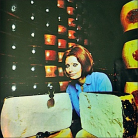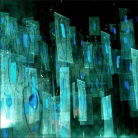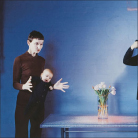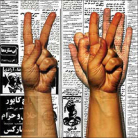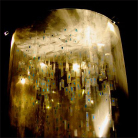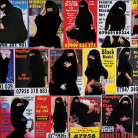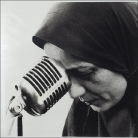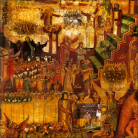PICTURING IRAN
Any discussion of contemporary visual arts production in Iran today is inevitably weaved within a tumultuous history rich in aesthetic tradition. Beyond a long and distinguished history of coffee house paintings, miniatures, fluid calligraphy, and humbling architectural design, Iranian identity has globally expanded after years of government censorship and war. Picturing Iran: Engaging the Past/Embracing the Future is a multi-disciplinary examination of this culture in the contemporary age; the exhibition focuses on the traditional patterns and age-old philosophical riddles that are embedded within the varying aesthetics of Iran’s Contemporary Art scene. The ground-breaking exhibition features 30 artists living and working in Iran alongside 40 others living in the Diaspora. The result is a multifarious portrait of contemporary Iranian artists who delicately articulate the complicated nature of their forging identity.
In Picturing Iran: Engaging the Past/Embracing the Future, over 500 works examine the means through which a young generation of artists is reconcile the daily implications of cultural and geographical distances with the search for individual artistic expression. The exhibition offers an unexpected insight into the artistic energy of a culture that is constantly evolving as Iranians living both in and out of the country, come of age living and working in contentious societies. While half of these artists such as Vahid Sharifian, Barbad Golshiri, Farideh Lashai and Jinoos Taghizadeh reside in Iran, the other half including artists such as Shirin Neshat, Shahram Entekhabi, Mitra Tabrizian and Shoja Azari has been interspersed in the Diaspora, generally based in the Western world.
These artists explore the deconstruction and reinvention of the self. Their art has resulted from this cultural schism, often swinging between openness and seclusion, dialogue and separatism. An era of cultural hybridization and sociopolitical turmoil makes it impossible to reduce Iranian art to any linear, artistic representation. Conditions of displacement and internal contradictions create an aesthetic breach in which myth and history, tradition and modernity are forced to confront one another. However, it is this kaleidoscopic perception of the world that allows the Iranian artist tremendous expressive potential. Contrary to one’s expectations, the artists living abroad often draw more on their cultural heritage, while those on the inside focus more on issues of everyday life without much regard to what ‘the outside’ views as specifically Iranian references. Yet, within these disparities, one element stands strong: the recurrent references, sometimes ambiguous, at times emotional, often nostalgic and on occasion satirical and even tragic to Iran the country, Iran the past, the Iran which has been lost and that which could be found. In its pursuit of the dichotomous relationship between the diasporic and native contemporary Iranian aesthetic, Picturing Iran: Engaging the Past/Embracing the Future touches upon a facet of the contemporary art world that is definitive of the post-modern era.

